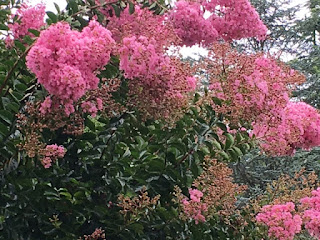The heavy downpour of rain, last Saturday evening, marked the end of "Naked Ladies" flaunting their figures in our garden. No--I'm not talking about the wonderful women of all sorts, celebrating bridal shower teas, baby shower teas and/or garden clubs holding meetings here while having tea. I'm talking about Naked Lady Lilies (Belladona amaryllis), of course! Those pretty in pink lacy flowers, whose greenery appears in early spring, then shed the leaves that once wrapped around their slender stems as soon as their rosey floral spring hats bloom to perfection. I'm sure you have some "wild women" a.k.a. Naked Lady Lilies in your garden, too, and enjoyed their feminine fragrance and coquettish allure while they were blooming.
 |
| Black-Eyed Susan's, wild women in their own right, seem a bit timid in the presence of bold Naked Ladies. |
This sorority of beauty queens has been around in the Southern United States since Thomas Jefferson introduced them to Monticello, way back in the 18th Century. He had little luck in growing them, as he wanted to constrain them to his greenhouse. However, "Naked Ladies" have other ideas and enjoy their unabashed freedom in the light of a sultry summer day, sometimes springing up where no one ever thought they would grow. They are considered hardy in zones 7-10. They also thrive here at Blooming Hill, located in Zone 6B, and come back every year, preferring to stick closely together (strength in numbers, I presume, since they wear next to nothing.)
In the meaning of flowers, (Floriography), "Naked Ladies" really don't translate into what their name implies or anything else, for that matter. However, if you take the meaning of Belladonna, the plant that is dangerous Nightshade and, combine it with the general meaning of a Lily, which is gaiety, coquetry and youthfulness, you kinda come up with a "Lolita-like" meaning for a Naked Lady Lily. Just sayin'...
I can't recall ever planting Naked Lady Lily bulbs but somehow, they showed up in a garden border off of the back porch years ago and re-bloom every season.
|
So, their garden-style burlesque show is over for now and the ladies' performances have all but disappeared for the season. Yet, true to form, I know those seductive Naked Lady Lillies will boldly return to dance in all of their glory again and again, in our summer garden, for years to come.




 July 4th is one good reason to celebrate our country. It's also, at least to a serious gardener, a way to usher in high summer and relish the zinnias taking hold and savor the burgeoning vegetable garden. But, July 4th comes and goes all too quickly and the high humidity days of late July start eyeing the nasty dog days of August as it looms closer and closer until, one morning we wake up and find August is already upon us. Already?!? Where did the fresh face of June go to? It seems to me that any day after the fourth of July is a blur of daily hand-to-hand combat with the weeds in lavender beds and, that battle does not yet look to be won during these first days of August and now waning summer. (#nuclear weeds!--haha)
July 4th is one good reason to celebrate our country. It's also, at least to a serious gardener, a way to usher in high summer and relish the zinnias taking hold and savor the burgeoning vegetable garden. But, July 4th comes and goes all too quickly and the high humidity days of late July start eyeing the nasty dog days of August as it looms closer and closer until, one morning we wake up and find August is already upon us. Already?!? Where did the fresh face of June go to? It seems to me that any day after the fourth of July is a blur of daily hand-to-hand combat with the weeds in lavender beds and, that battle does not yet look to be won during these first days of August and now waning summer. (#nuclear weeds!--haha)






